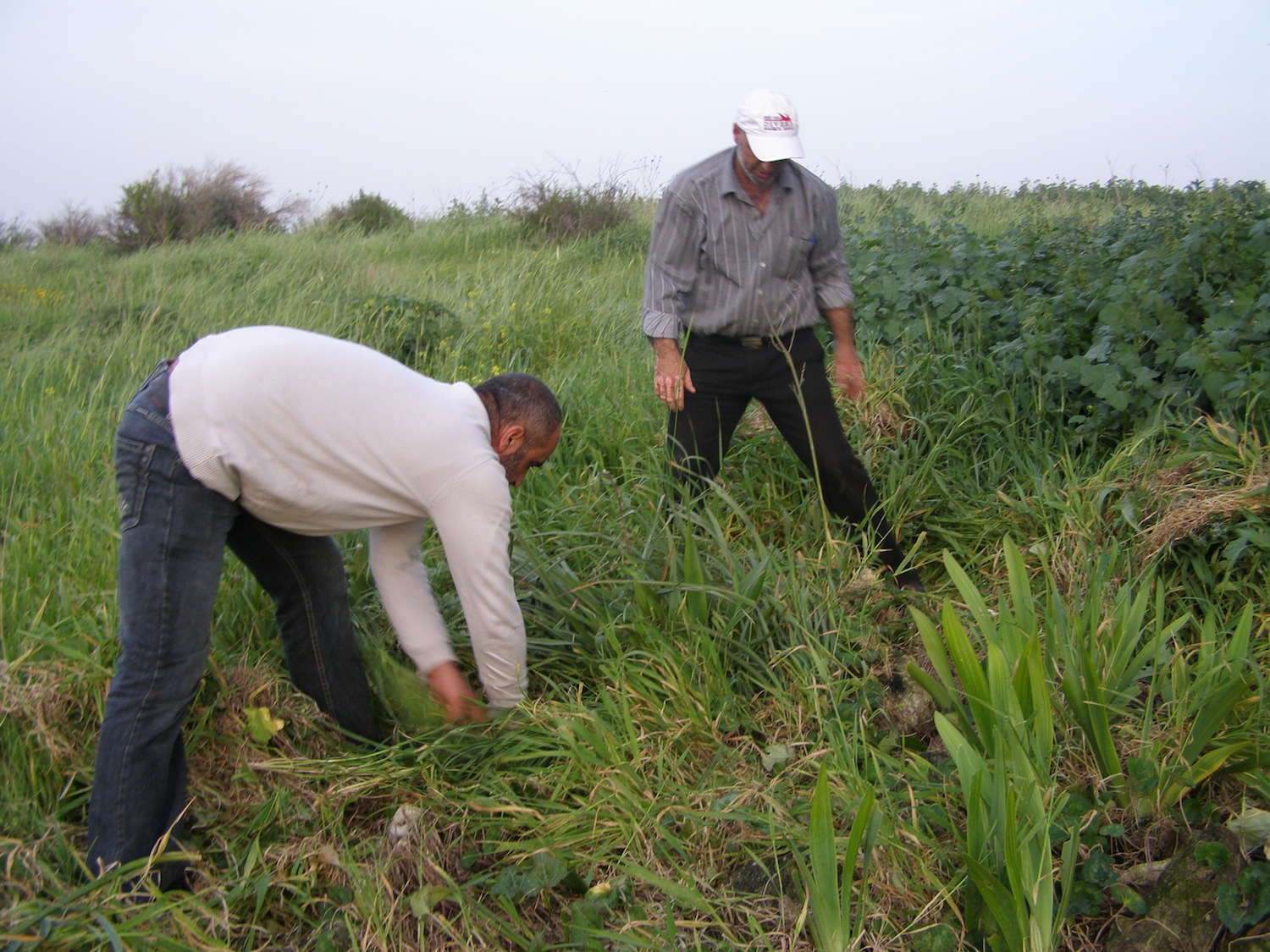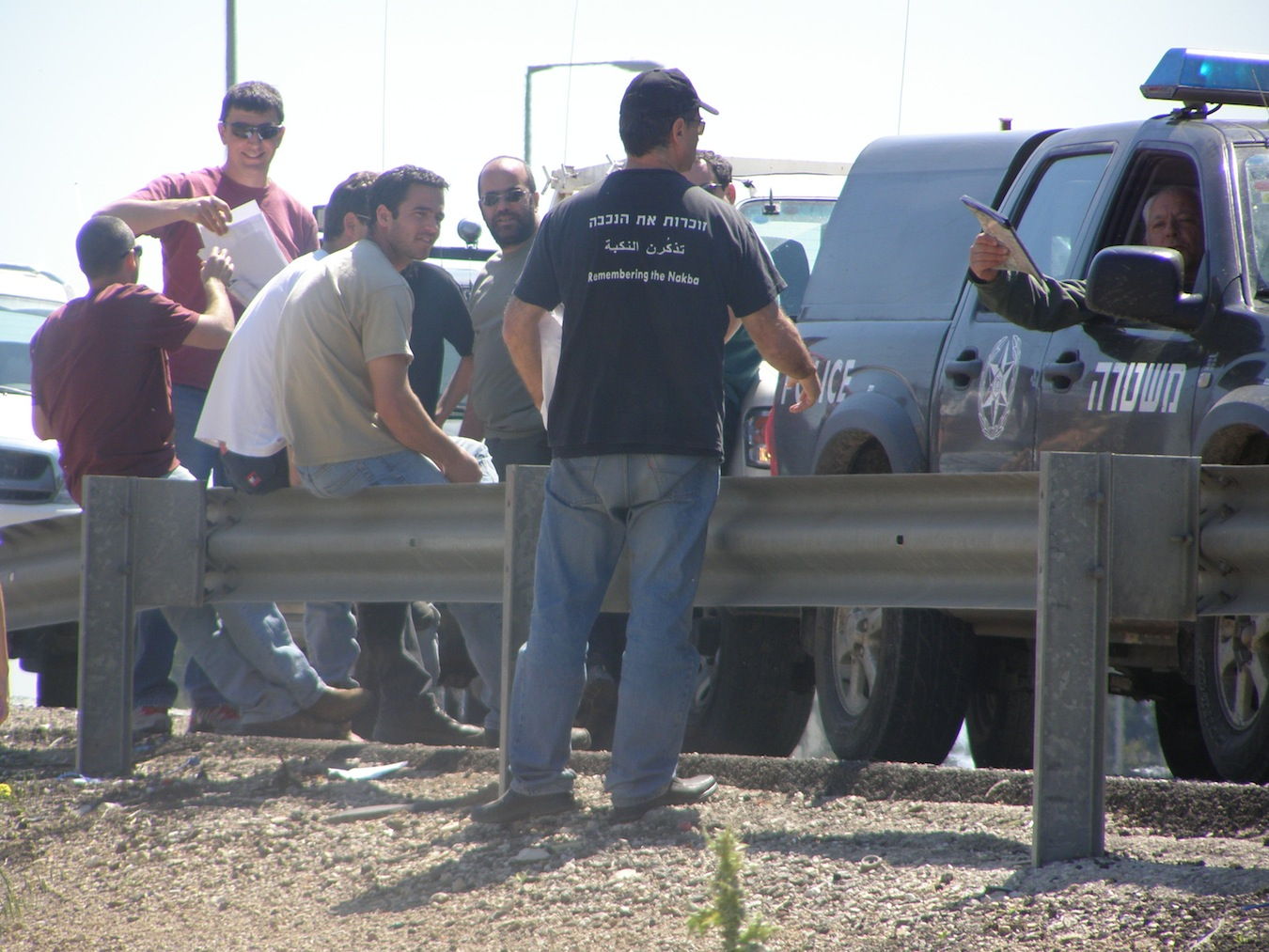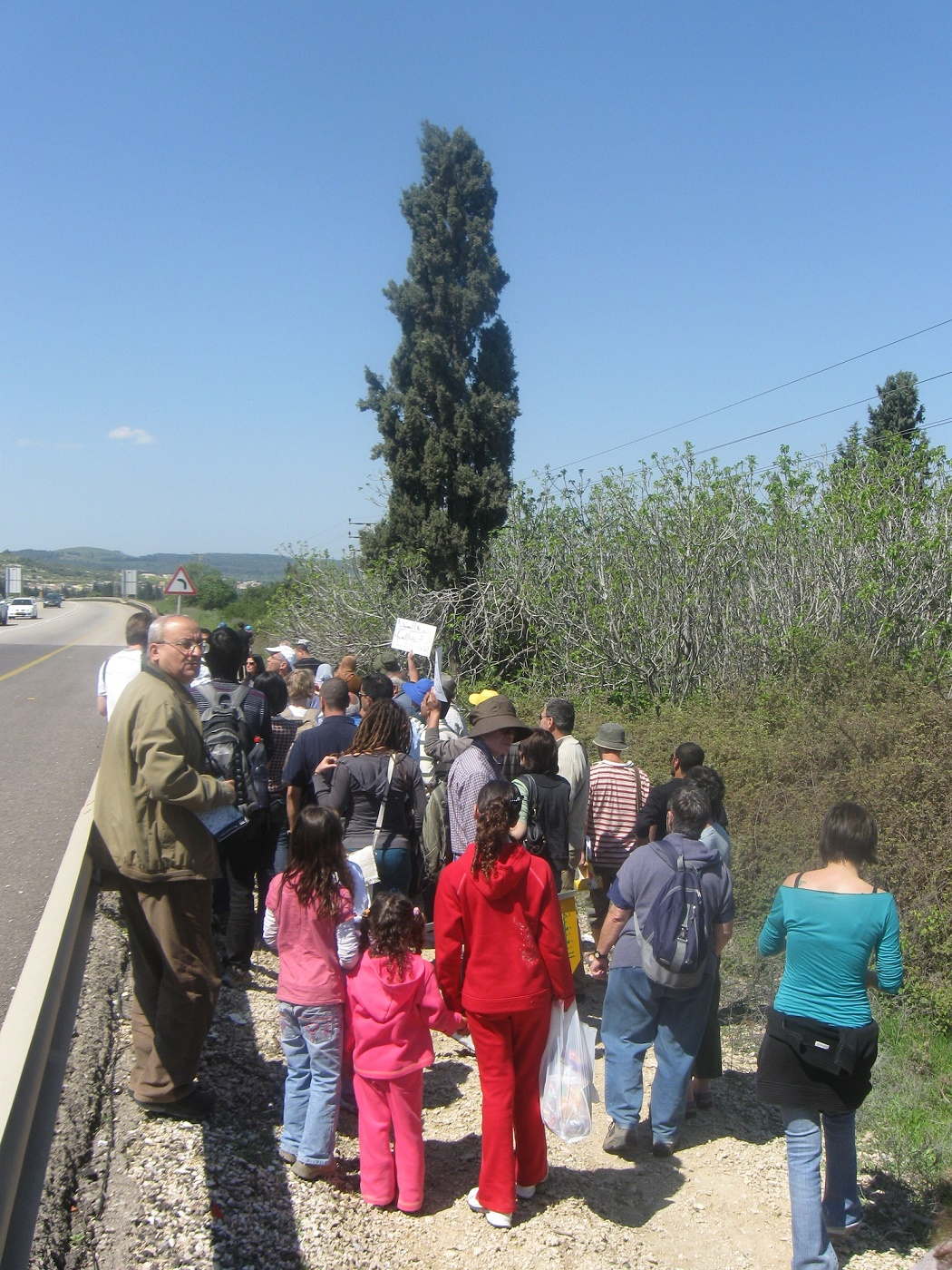Kibbutz Mishmar HaEmeq, with the help of the Israeli police, prevented Zochrot and refugees from the villages of al-Ghubayya al-Tahta, al-Ghubayya al-Fawqa and al-Naghnaghiyya to hold a commemorative ceremony and a tour among the ruins of the demolished villages. The tour was held nearby, with approximately 100 participants. After the ceremony we drove by bus past the locations of the destroyed villages and Kibbutz Mishmar HaEmeq. The site of al-Ghubayyat, most of which is still empty and used by the kibbutz for pasture, turned out to be uninhabited, green and quiet. Kibbutz Mishmar HaEmeq, on the other hand, resembled a fortress. Groups of young people stood ready at each of the entrances to the kibbutz, supplied – from what we could see – with walkie-talkies and off-road vehicles. When the event began another group of people from Mishmar HaEmeq stood near the policemen, observing the tour from the sidelines. This group had prepared a news release and a number of rare photographs to prove that there was coexistence here between Jews and Arabs before 1948. There aren’t any photographs of coexistence after 1948, because in that year, when the state of Israel was established, the al-Ghubayyat villages no longer existed, nor were many other Palestinian villages in the neighborhood of Mishmar HaEmeq still standing. Al-Ghubayya al-Tahta, al-Ghubayya al-Fawqa, al-Naghnaghiyya, al-Mansi, Ein al-Mansi, al-Lajjun, al-Kafrayn, Khubayza, al-Butaymat, Umm al-Shuf, Dalyat al-Rawha, al-Rihaniyya, Umm al-Zaynat, Khirbat al-Mansura, Qira w’Qamun, Abu Zurayq, Abu Shusha, Lidd al-Awwadin, al-Waraqani and others had been located near Mishmar HaEmeq before 1948, and all had been made to disappear from the landscape.
The tour, which had intended to focus on the al-Ghubayyat villages, gained a new dimension and turned into a commemoration of all the villages from the area. Given Mishmar HaEmeq’s refusal, we decided to begin the event at the al-Mansi cemetery (next to the gas station at the entrance to Moshav Hayogev). Many of the tour’s participants were refugees from the area’s villages, who today live in Umm al-Fahm. The tour began with accounts of their lives before the nakba. Abu Khalid, from Ein al-Mansi, tearfully and emotionally recalled his village, showed us the nearby graves of his grandfather and uncles, pointed to a hill and explained where his house had stood until April, 1948. Adnan Abd al-Hadi described his village, al-Lajjun, and the immoral expulsion of its inhabitants; he emphasized that the return of the refugees is a precondition for reconciliation. Shawkat Abu Zabatta spoke on behalf of the al-Ghubayyat refugees and noted that it would be possible for Arabs and Jews to lived together, as they did in Arab countries before the Zionists took over the country. Ahmad Kiwan, a political activist, spoke about the anger of the tour’s participants and their disappointment at being prevented from reaching the village, and Eitan Bronstein, on behalf of Zochrot, supported returning the refugees to their villages.
The participants received the booklet, “Remembering al-Ghubayyat,” that had been prepared especially for this occasion, as did the policemen and kibbutz members who accompanied us. The police did not allow us to erect three signs by the roadside bearing the names of the villages. We began walking to al-Ghubayyat. On the way, Abu Khalid continued talking about Ein al-Mansi, about his lands, his house and the spring. He also went over to the policemen, telling them how painful it is for him. We walked about two kilometers, until the police stopped us. We gathered in a field overlooking al-Ghubayyat, one kilometer away. According to the refugees, “al-Ghubayyat was there, on the hill, between Midrakh Oz and Mishmar HaEmeq; al-Ghubayya al-Tahta was down below, close to the kibbutz ; al-Ghubayya al-Fawqa was on the hill; and al- Naghnaghiyya was found just past the new neighborhood in Midrakh Oz. That road, called the Haifa-Jenin road, separated the villages’ built-up area from their agricultural lands in Marj Ibn-'Amir (the Jezre’el Valley). Al-Ghubayyat’s lands were here, where we’re standing on the side of the road, up to the Al-Muqatta' River (the Qishon).” al-Hajja Raifa Abu-Zabatta, who had been born in al-Ghubayya al-Fawqa in 1937 and now lives in Umm al-Fahm, walked with us very energetically, saying that she “remembers that the inhabitants of al-Ghubayya al-Tahta came to us to hide, reporting that the Jews from Mishmar HaEmeq had attacked them. At night shots were fired in our direction, and the whole village fled. My house was there on the hill, next to the oak tree. We fled to al-Mansi, and then to al-Lajjun. The Jews attacked everywhere we went. After they attacked al-Lajjun, we fled to Umm al-Fahm. People scattered in all directions – to Jenin, Jordan, Syria. My brothers and I remained in Umm al-Fahm to this day.
The 70 Palestinian and 30 Jewish participants in the tour were disappointed that they weren’t able to reach their intended destination, but they learned something significant that day, particularly from the fearful behavior of the residents of Mishmar HaEmeq, who were unable, even after 62 years had passed, to confront the truth concealed among the ruins of al-Ghubayyat.

אלעֻ'בַּיאת - סיור / al-Ghubayyat - Tour

אלעֻ'בַּיאת - סיור / al-Ghubayyat - Tour



